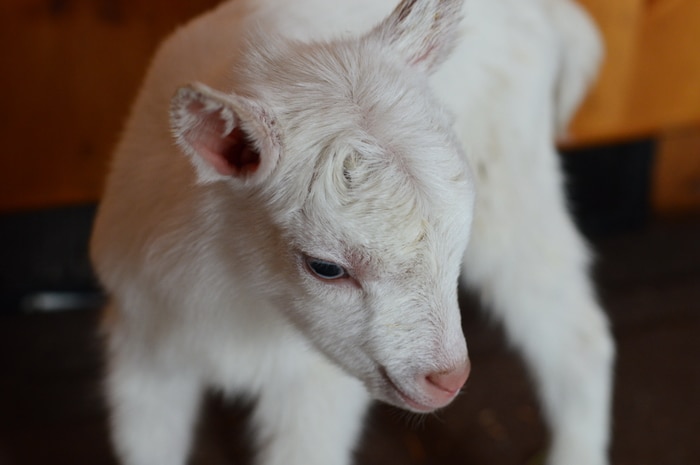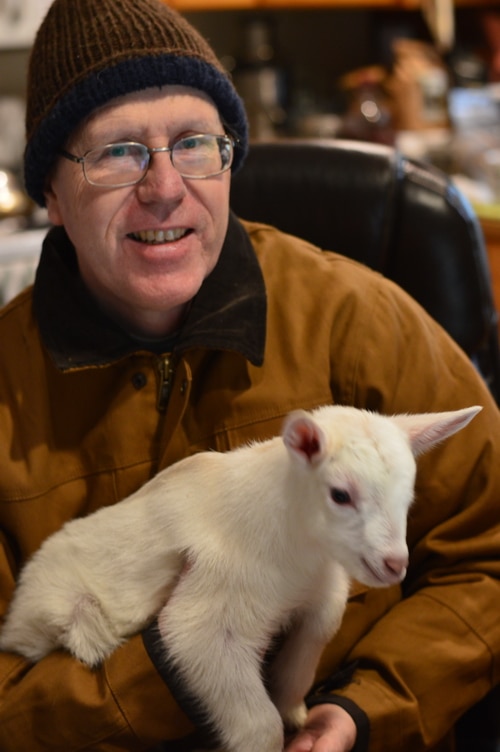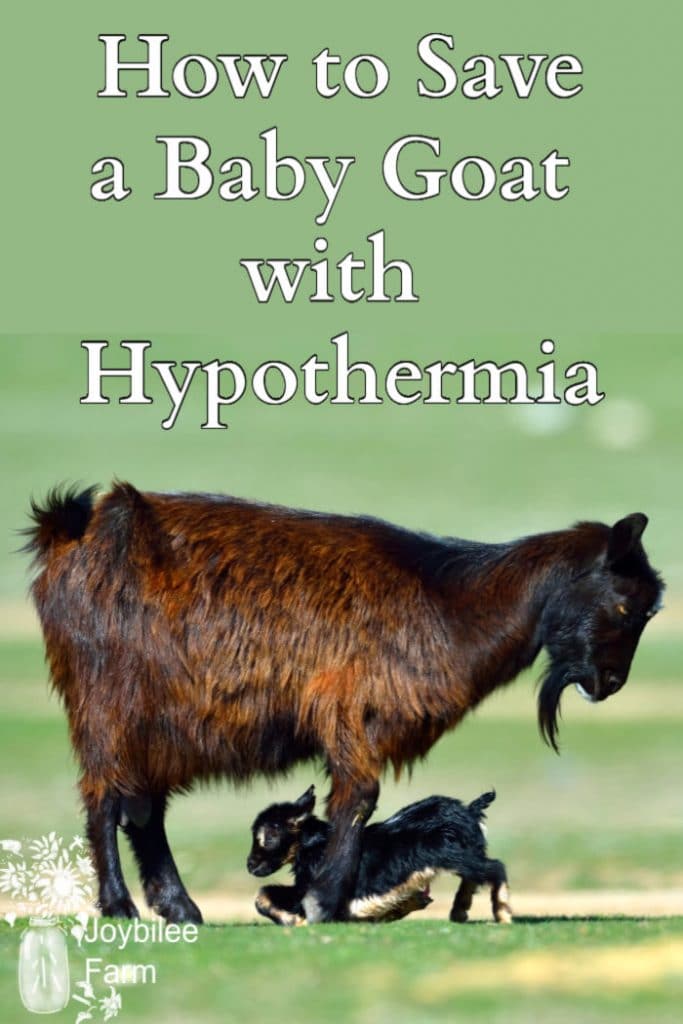How to Save a Baby Goat with Hypothermia
During lambing and kidding season, baby animals born at night can get chilled. In cases of baby goat hypothermia (often paired with hypoglycemia) immediate action is necessary and there is no time to call the vet. These steps are our tried and true method to revive kids and lambs that got chilled at birth.
Yesterday, at 6 am Robin came in from the barn, holding a cold, wet, limp baby goat. She had her eyes open but she was completely unresponsive. While still breathing, there seemed to be no life left in her. Her tongue was cold. Her stomach was empty. She had only minutes of life left, without immediate intervention. In a situation like this, where life is in the balance, you don’t have time to call a vet. This is a homestead emergency.
This kid had hypothermia and possibly also was hypoglycemic. Since the kid’s tongue was cold, there is no point in feeding her warm milk, as she can’t swallow and she could get it in her lungs. Even if you got it into her stomach, she could aspirate it.
How to address baby goat hypothermia
1. Fill up a sink with warm water.
The water should be warmer than your hands but no so warm as to burn the baby.
2. Immerse the goat or lamb in the sink of warm water.
Immediately immerse the kid up to her neck in the warm water, while at all times holding her head above the water. Move the baby through the water, while keeping her head above the water. As the water cools, drain some water out of the sink and replace it with warmer water. Since the goat or lamb is cold, some of the heat will be removed from the water and it will need to be replenished.

3. Put a small amount of honey or maple syrup (not corn syrup or sugar) under the goat’s tongue.
Many times a baby goat or kid that goes limp and cold overnight has hypoglycemia, as well as hypothermia. When they are unresponsive and not sucking, you don’t want to force warm milk into them. While you could tube feed them, an inexperienced person runs the risk of getting fluid in the baby’s lungs with this method. On the other hand, honey or maple syrup placed under the tongue will be absorbed immediately into the bloodstream, helping to warm the animal. It also helps their digestive system start back up after being chilled and shutting down.
4. Rub the baby’s legs and back to restore full circulation.
In cases of baby goat hypothermia, the goat has a reduced heart rate, a reduced breathing rate and slower blood circulation. By rubbing the limbs, blood circulation can be restored. This will also help move the heat from the limbs to the baby’s core.
5. Be patient.
Baby’s don’t normally get limp and unresponsive in seconds, and it takes up to 45 minutes to warm them to the core. As the baby warms you will feel her tongue get warmer. So check on the temperature of the baby’s tongue to see how your patient is progressing. As she warms she will begin to hold her own head up. Her eyelids will flutter and then blink. She will involuntarily move her own legs as if she is swimming in the water. This is encouraging. Don’t try to feed her yet, you are seeing involuntary movements. But at this point, you should have a bottle of milk warming in a cup of hot water, ready for when the baby becomes fully alive.
If the baby is only a little chilled, and has active shivering or is wet, you can just warm them with a blow dryer and towel rubbing. This keeps their scent intact and makes it more likely for the mother to accept them once the baby goat hypothermia is addressed.

6. Remove baby from the sink and dry quickly
Once the baby kid or lamb is warm, indicated by a warm tongue, and controlled movement, you will want to dry her quickly, without chilling her. The best way to accomplish this is to hold her in the sink of water while pulling the plug on the water. With a towel begin at her head and dry her ears and head thoroughly by rubbing briskly with the towel. Squeeze her limbs and body fur to wring out the excess water and wrap her immediately in a towel. Then only uncover part of her to dry thoroughly by vigorous rubbing and blow drying with a hairdryer. As each part is dry, uncover another part to dry, until she is completely warm and dry. Partway through drying her, offer her milk from a bottle, if she will take it. (See step 7)
7. Warm up some milk.
Ideally, you will have some warm milk taken from the baby’s dam. If this isn’t possible goat’s milk from your fridge or freezer can be warmed in a baby bottle set in a measuring cup of hot water. Baby probably didn’t eat anything the night before this emergency and will be hungry. It is essential that this first feeding be warm. You will want to avoid using cow’s milk on baby goats or lambs, as cow’s milk can cause an allergic reaction in some goats or lambs.
8. Feed the baby goat or lamb with a bottle of warm milk.
Wait until the baby begins to suck on your finger when her tongue is warm. Then insert the nipple into the baby’s mouth while gently moving the nipple in and out to encourage the baby to swallow. You should see swallowing movements. If the baby doesn’t begin to swallow immediately, you may need to take the steps outlined in “3 Easy steps to get a baby goat or lamb on the bottle, and save her life.”
Do not feed the baby goat until it has warmed up fully. Their stomach stops digesting when their body shuts down from the hypothermia, and they need to be fully warm before you feed them so that their stomach is active again. You may need to give a small amount of plain raw yogurt mixed into the milk if it is a case of older baby goat hypothermia, to help restart their stomach.

9. Using selenium to treat a weak or floppy kid.
If these steps don’t bring the results you want, or if your patient did not receive a selenium injection at birth, you can give the baby an sq injection of selenium/vitamin E, available from your local farm store. Every goat or sheep breeder should have a bottle in their farm first aid kit. Along with 3ml syringes and 18 gauge – 1 inch needles. A selenium deficiency causes muscle weakness or even death. But an overdose of selenium can also harm a kid or lamb, so only use selenium if your goat or lamb has not already had a selenium injection at birth.
Selenium does not automatically address baby goat hypothermia, and the priority with a weak or floppy kid should be making sure their internal temperature is up, and they have a bit of sugar or milk. Then, if they are still floppy and not responsive, but their tongue is warm, they should receive selenium.
10. Putting the baby back with her mother.
Since the baby has been washed in the sink of warm water, she will no longer have her birth smell and may be rejected by her mother. This is more likely if the kid is less than a week old. Since the baby was hypoglycemic, it is very likely she already has been rejected and this is why the emergency came about in the first place. You will probably have a bottle baby on your hands. You can attempt to put her back with her mother. Watch and see if her mother shows any mothering instinct toward the baby. If the doe or ewe is solicitous of her offspring then you can safely leave them together. If not, you will need to bottle feed the baby with her mother’s milk or a substitute until she is at least 8 weeks of age. The mother can be milked out twice a day and the baby fed exclusively from her own mother. Or you can feed goat’s milk or milk replacer made for lambs. Milk replacer contains animal products like bovine tallow, and some goats have allergies to these animal byproducts. Tallow is not part of the natural diet of ruminants. So watch carefully for stomach distress and stop feeding immediately if any stomach distress occurs. You may be able to find a source of raw goat’s milk from a local breeder. If the milk is from disease free animals you can feed it raw, but if you have any doubt as to the disease status of the herd, always pasteurize the milk to protect your own herd from Caprine Arthritis Encephalitis (CAE)

Your Turn:
Did you find this article helpful? What would you add to ensure success at reviving a floppy kid or lamb?
During an emergency, you won’t have time to look for this article on the internet. Please take a minute and save a PDF copy using the printer icon at the bottom of this post. Or print a copy for your homestead first aid kit.
This is the second in a series of articles on natural care for livestock.
Part 1: Before you call the vet: 3 easy steps to get a baby lamb or kid on a bottle and save her life
Part 3: No Time to Call the vet: Removing ticks in llamas and alpacas
Other resources:
Natural Goat Care
The Complete Herbal Handbook for Farm and Stable
Meyenberg Powdered Goat Milk, Vitamin D, 12-Ounce Cans (Pack of 3)
Living with Goats: Everything You Need to Know to Raise Your Own Backyard Herd
Angora Goats: A Country Girl’s Guide (Country Girl’s Guides)
Sav-A-Kid 26% Milk Replacer, 8 Lb




Great idea. I’ve done the same with baby goats, lambs, chicks, baby bunnies, even ducklings. I believe they not only respond to the body heat but also your heart beat. Excellent idea to keep honey sticks on hand near the barn. Great tips.
Great advice! We’ve had goats for a bit now, and I did not know about the honey or other sweet under the tongue. Thank you!
A little hint if you can’t access a sink and warm water: open or pull up your shirt and put the kid right up against your skin. Be sure its nose is out so it has easy access to air! Yes, it is cold. Yes it is slimy. Yes it is disgusting. And oh my! That shower will be needed! But our little doe came around. I was able to keep her from getting worse while I got to the truck and got the heat going on full blast. Our home is several miles from our farm and we just have cold running water at the farm.
I’ll be storing some honey sticks (sold at our local orchard) in the glove box of the truck!